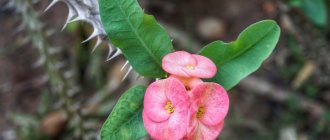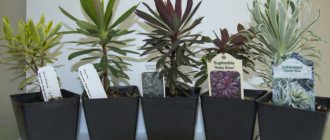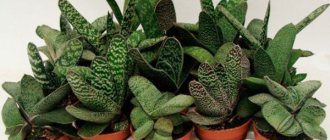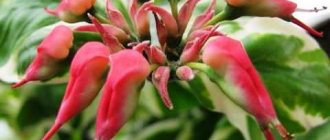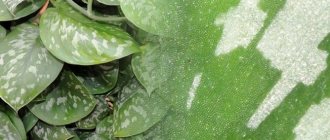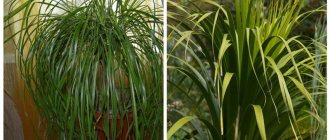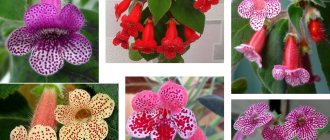Description
Garden spurge belongs to a large genus, which includes about two thousand plant species, which, in turn, belong to the Euphorbiaceae family.
The huge species diversity includes both annual and biennial plants, as well as perennial plants. Among the many euphorbias there are highly ornamental and weedy species that gardeners have great difficulty removing from their plots.
For the most part, representatives of the genus are found in African territories, but about 20 species are perfectly adapted to the harsh realities of the Russian climate.
Unfortunately, precisely because of the species diversity, it will not be possible to give a general description of milkweeds , since the plants have strong differences in stem height, leaf shape and bush structure.
But all milkweeds have one thing in common: milky sap.
For people who are allergic to latex, contact with the milky juice is strictly prohibited. The fact is that the juice contains rubber - a natural raw material for the production of latex.
You need to be very careful when working with milkweed: a couple of drops of juice on the skin can cause itching, redness and even ulcers.
If it gets into the eyes, it leads to partial loss of vision and severe burns to the cornea. The juice that reaches the stomach causes severe vomiting , diarrhea, and increased body temperature.
When they bloom, milkweeds produce attractive, brightly colored petals that are mistaken for flowers. But these are not petals, but leaf plates that are designed to attract insects to pollinate the flower itself, which is rather inconspicuous.
Botanical description: name, features and differences
Euphorbia obese, or plump, fat (lat. Eupforbia obesa) is a perennial succulent from the genus Euphorbia of the Euphorbiaceae family. It has the shape of a ball, which makes the plant similar to cacti. In the USA, the succulent is also known as a “baseball plant” because it resembles a ball.
- The root system is axial, with a small number of lateral roots; the root has the shape of a cone with a blunt end.
- The trunk is the plant itself - overgrown, dense, unbranched. It has a dome-shaped or almost spherical shape when young and elongates to a cylindrical shape as it grows. Forms eight faces. The color is gray-green to brown-green with transverse stripes of terracotta or pale violet.
The average height of the plant is up to 30 cm, diameter is 8-10 cm. The ribs on the trunk are wide, vertical, slightly raised above the surface. There are small brown bumps on the tops of the ribs.The peculiarity of this species is that it is the only one of the euphorbias that does not branch and has a solid body.
- The leaves are small, fall off quickly, and have a rudimentary function.
- The plant is dicotyledonous, heterosexual - female and male flowers are formed on different representatives. The inflorescences are grayish-green, located at the top of the trunk. Pedicels branch. The flowers themselves are cup-shaped, 2-3 mm in diameter. Female flowers are wider. The aroma is very subtle. Cross pollination with the help of insects.
- The fruit is a three-nut tree, 5-7 mm in diameter, with one seed in each nest. Ripe fruits explode, scattering small round seeds.
Garden spurge: types, photos and names
From almost 2000 varieties, every gardener will be able to choose a plant to their liking. Among the most popular ones used for garden decoration are the following.
Multiflora or polyflorum (Euphorbia epithymoides)
The natural habitat of this species is the mountainous regions of Europe. The perennial plant in the process of development forms a beautiful rounded crown of the correct shape, which, with a bush height of 0.5 to 0.7 m, creates an attractive picture.
The basal leaves are scaly, they form a rosette; the same ones that are located on the stem, round in shape. The leaf-spreads are painted in a light yellow tone, which acquires a beautiful orange color at the time of flowering. The flowering period takes a little more than a month, occurring in May – June.
Almond (Euphorbia amygdaloides)
A fairly large perennial, whose height can reach 0.7 m. Moreover, the underground part, represented by a horizontal woody root, often coincides in size with the above-ground part.
In the first year of life, the bush produces vertically oriented shoots, which become woody over time. They are densely covered with petiolate dark green leaf plates of an elongated elliptical shape.
The apical rosette of leaves overwinters on the bush, and the next year small shoots appear from it, covered with sessile greenish-yellow leaves framing the peduncles.
Flowering occurs in April - May.
Cypress (Euphorbia cyparissias)
A low (up to 0.4 meters) variety of milkweed with erect shoots, densely covered with needle-like leaves. As it grows, it forms dense clumps.
A notable feature of the plant is its ability to re-bloom : the first wave occurs in May, the second at the beginning of autumn. When flowering it spreads a pleasant aroma.
The petals-spreads of some varieties may have a delicate pink color, but in most plants they have a purple or burgundy tint.
Marginata (Euphorbia marginata)
Grown as an annual, it is distinguished by well-branched, vertically oriented shoots, whose height can reach 0.8 m.
The shoots are densely covered with light green, fairly large (up to 4 cm in length) oval-shaped leaf plates. The arrangement of leaves can be alternate or whorled.
The bush is characterized by long flowering , which lasts from July to mid-September. At this time, the apical leaf plates of garden milkweed receive a bright white border, and the bedspreads surrounding the inflorescence turn completely white.
Myrtle leaf (Euphorbia myrsynites)
This plant is simply irreplaceable when decorating rocky areas or alpine hills. The fleshy creeping stems are not too tall, their length is only about 0.2 m. The shoots form rosettes.
On the stems there are a large number of medium-sized leaf blades of an obovate shape with a remarkable greenish-blue color.
At the top of each shoot, capitate inflorescences are formed . The leaves that form the blanket are tightly curled around the flower and vaguely resemble a rose with greenish-yellow petals.
The flowering period takes all of May and most of June, but in warm springs flowering can begin in April. The plant reproduces well by self-seeding; this must be kept in mind when planting.
Capitulata (Euphorbia capitulata)
An interesting compact variety. Prefers rocky, well-lit areas. The height of the shoots is about 0.1 m. The flowering period occurs at the end of spring, and at this time capitate spurge becomes an expressive decoration of the site.
Stone-loving (Euphorbia petrophila)
A herbaceous perennial plant whose shoots at the base become woody over time. The color of the stems has a reddish or brownish tone. The height of the shoots does not exceed 0.2 m.
Foliage from previous years leaves scar marks on the stems, which can be used to approximately determine the age of the plant.
The leaf blades have an elongated elliptical shape, about 2 cm in length, and are distinguished by the presence of a serrated edge. The color of the foliage is greenish-gray, the integument is leathery, and the leaves themselves are quite dense.
Flowering occurs at the end of May and lasts until the beginning of July. The inflorescences are wrapped in burgundy egg-shaped blankets ; they are formed by 3–5 flowers.
Swamp (Euphorbia palustris)
The color of the erect long shoots, reaching a meter in length, is noteworthy - it is burgundy.
There is a lot of foliage on the shoots; it is rich green with a noticeable light cream longitudinal vein. The flowering period occurs at the end of May, at which time the plant forms fiery yellow inflorescences.
Chin or caper (Euphorbia lathyris)
This variety has a two-year life cycle and quite impressive growth (up to 1.5 m). The plant is suitable for areas located in light shade.
In the first year of life, milkweed produces an erect shoot, distinguished by a reddish color. In the second year it forms flowers and dies after flowering. The variety reproduces well by self-sowing.
Vegetable garden (Euphorbia peplus)
Since this variety is completely undemanding to soil quality and instantly reproduces by self-sowing, it is often pulled out as a weed.
But a certain decorative quality is still inherent in the low bush. And if you monitor the growing season of the plant, and immediately remove the corollas after flowering, then garden spurge may well be present on the site.
Griffith or fire (Euphorbia griffithii)
This large (up to 0.8 m in height) plant is a striking example of highly decorative milkweed. Its vertical shoots form a rounded bush and are densely covered with elongated leaf blades with a bright longitudinal stripe on each.
During the flowering period, inflorescences with red, orange or yellow petals appear on the shoots.
Cornigera (Euphorbia cornigera)
Not too bright, but an atmospheric plant, whose bush is formed by erect shoots up to 0.8 m long. The flowering period occurs in the second half of summer.
The plant forms inflorescences of horny greenish-yellow flowers. The leaves are elongated-lanceolate, dark green, with a noticeable light stripe in the center.
Schilling's (Euphorbia schillingii)
A tall bush can reach 1 m in height and serves as an excellent background for flowering perennials without overwhelming them with its blooms.
The color of the petals is yellowish-green, but not too bright. The leaf blades are elliptical in shape, rich green in color, and are distinguished by a noticeable longitudinal stripe.
Mediterranean or sculptured (Euphorbia characias)
It is distinguished by its large bush size (up to 1.5 m), early and long flowering. During the flowering period, the bush is abundantly covered with inflorescences-tassels of light green color. The bluish-green leaves have a beautiful elongated shape.
Altai (Euphorbia altaica)
A herbaceous perennial whose height does not exceed 0.2 m. The shoots do not branch; they are divided into generative and vegetative.
The shape and size of the leaves vary: at the base of the shoot they are ovoid and medium-sized (about 3 mm), at the top of the shoot the length of the leaf can already reach 3 cm, and its shape takes on an elongated oval shape.
During the flowering period, yellow-green umbrella inflorescences with a wide bell-shaped leaf-spread appear on the tops of the shoots.
Rocky (Euphorbia rupestris)
A low bush, whose vertical shoots do not exceed a height of 0.2 m. There are few leaves on the shoots, thanks to which the openwork shape of the bush .
The leaf plates themselves are very beautiful; they constitute the main decorative value. The leaf length can reach 4 cm with a width of 1.5 cm; they are painted in a bluish tone, but have bright white veins.
Scaly (Euphorbia squamosa)
This spurge attracts attention with the correct spherical shape of the bush. The height of the plant reaches 0.4 m. Oval light green leaves and yellow inflorescences complete the picture.
Breeding rules
Unlike other species, milkweed reproduces only by seeds. Selection of material is possible only if there is a male and female plant.
First you will have to carry out the pollination procedure using a cotton swab or brush. Afterwards, you need to cover the female succulent with gauze or cotton wool until the seeds are fully ripened.
In nature, as soon as the seeds ripen, the box with them opens and shoots them over a long distance. This is how the plant develops new territories. This cannot be allowed to happen at home. Once on the gauze, the seeds will fall nearby, and you won’t have to look for them throughout the room.
Having collected the seed material, you can begin planting in the following order:
- Prepare a container with coarse sand mixed with gravel;
- The seeds are placed in the substrate and lightly sprinkled with sand;
- The container is moistened and covered with film;
- For better germination, seeds are placed under a lamp;
- Shoots appear in 2-3 weeks.
The film should not be removed immediately after the sprouts appear. They should strengthen, gradually getting used to room temperature. After three months, young plants can be planted in separate flowerpots.
Growing plants from cuttings
Euphorbia is an unpretentious crop that is easy to care for and does not cause much trouble when growing.
Plants propagate well from root or stem cuttings.
To do this, the prepared material is placed in a peat substrate. The plantings are covered with film to create a greenhouse effect and regularly sprayed with a spray bottle.
For quick rooting, you need to maintain high air humidity and keep the substrate slightly moist all the time.
Due to high humidity, the greenhouse is opened daily for ventilation to prevent mold from growing.
A sign that the cuttings can be planted in individual pots and the shelter removed will be the appearance of new shoots.
Plant care
Euphorbia obese is an unpretentious plant, so it does not cause problems when grown at home. Despite its resistance to environmental factors, for better growth and flowering it has some care requirements.
Temperature and lighting
The plant comes from a warm climate, so in spring and summer it feels good at temperatures of +25...+30 degrees. It does not require additional heating; it is enough to place the spurge in the warmest place in the room - for example, a south or south-east window. Here the light-loving succulent will receive a sufficient amount of sunlight.
This type of milkweed is not afraid of direct sunlight, and needs it for good growth and development.
In winter, a dormant period begins, during which spurge firmly withstands temperatures down to -10 degrees in the absence of watering. It is enough to move the succulent to the north side of the apartment or house from the end of October to April.
Watering
A large amount of water is detrimental to the plant ; this is the most common mistake of many beginning succulent lovers. During the active growing season, Euphorbia obese is watered once every two weeks with warm, settled water. Once a month, the plant can be irrigated with a spray bottle. In winter, watering is stopped completely if the succulent is transferred to sub-zero temperatures, or watered no more than once a month.
Top dressing
Feeding of milkweed obese is carried out only during the breeding season. Basic fertilizers for succulents and cacti are suitable. During the period of active flowering, fertilizing is applied at the root once every two to three weeks with regular watering.
Nitrogenous fertilizers are contraindicated for this species!
The most popular fertilizers are:
- Pokon.
- Hylea.
- Good power.
The working solution is diluted according to the instructions indicated on the package.
Pot and soil
This species requires a shallow but wide pot with a hole in the bottom for normal air circulation in the substrate. Ceramic containers work best. Any soil will do, but a special soil mixture for cacti and succulents, which can be purchased at any flower shop, is considered optimal.
Planting and care in open ground
Many types of milkweed are completely undemanding in terms of keeping conditions and reproduce well by self-sowing. But in order for the bush to actively develop and bloom luxuriantly, it will require a simple set of care measures.
Selecting a location
In most cases, preference should be given to open, well-lit areas with loose, permeable soil. But even on poor, acidified soils, spurge will not disappear, the flowering will simply be less spectacular.
Deadlines
The optimal time for planting seedlings or rooted cuttings will be mid-May - the time when the threat of return frosts has completely passed.
Outdoor sowing of seeds
The second half of May is also suitable for sowing seeds in the ground.
To improve the germination of seeds, it is recommended to stratify them (keep them in the refrigerator for two weeks), after pre-treating the surface with fine sandpaper.
Watering mode
Euphorbia is surprisingly unpretentious; it is recommended to water it only in hot weather .
However, you should not allow the soil to dry out after planting young plants - this threatens to reduce the growth rate of the plantings.
Purchase and adaptation
You can buy an adult specimen both in online stores and from amateur flower growers. This pleasure costs 700-1000 rubles.
It’s cheaper to buy succulent seeds and try growing it yourself. One seed will cost about 50-60 rubles, but most often they sell them in several pieces.
After the purchase, it is worth assessing the soil:
- If this is a special substrate for succulents, then replanting is not necessary.
- If it is a peat mixture (it is easy to recognize by its dry, crumbly structure), then it must be replanted. In peat, the flower will not be able to feed normally and will soon die.
Diseases and pests
The only disease that poses a threat to milkweed is a fungus, the development of which is provoked by high soil moisture. To prevent the development of the disease, it is enough to follow the watering regime.
Dangerous pests include mealybugs and spider mites. Insecticides will help reduce insect activity.
Reviews from flower growers
The plant's unpretentiousness to conditions and good germination and survival of seeds are noted. Even in ordinary wet sand, seeds germinate excellently.
The main disadvantage of young sprouts is their rapid stretching. It is necessary to provide them with a lot of light and warmth. For the first 3-4 months, the “juveniles” have to be provided with additional lighting almost around the clock.
Euphorbia Tuchny has very slow growth, although for decorative compositions from different types of succulents this is rather a plus (transplantation is carried out extremely rarely).
The variety has become so popular among lovers of green exotics around the world that there is a threat of its extinction in nature. Now this species is protected by law, and harvesting it is strictly prohibited. Therefore, more and more often you can find on sale zoned plants grown in our latitudes from seeds.
Possible growing difficulties
The overseas plant is rarely damaged by insect pests and diseases. To avoid leaf fall, do not allow the soil under the flower to dry out, keep it in an excessively cool room, or suddenly change the light regime. In order not to provoke rotting of the roots of indoor milkweed, do not water the crop too much. Any manipulations with this plant should be done with gloves!
Article protected by copyright and related rights. When using or reprinting material, an active link to the women's website www.inmoment.ru is required.
Tags: indoor spurge
Botanical characteristics
Euphorbia is the largest genus in its family, which includes annual and perennial succulent and cactus plants - herbs and shrubs, sometimes even trees.
All forms have a common feature - when mechanically damaged or cut, they release poisonous milky juice, which is dangerous and harmful to humans and animals, it causes an allergic reaction, severe burning and inflammation of the mucous membranes.
Description:
- the type of stem depends on the subspecies, it can be leafy, without thorns, or with thorns, there are fleshy and cactus-like, formed by edges and without foliage, most often weakly branched, sometimes prostrate branched, up to 2 m long;
- the root system is vertical, creeping or ascending;
- the arrangement of foliage is alternate, opposite or whorled, leaf blades are entire or serrated, often with interpetiolar stipules;
- most are flowering, inflorescences are monoecious, in rare cases dioecious, without petals and mostly without sepals, antherous or pistillate;
- fruits in the form of a three-lobed smooth or tuberculate three-nut, the seeds are smooth or uneven;
- milky juice is contained in branching vessels that do not have partitions.
In the natural environment, spurge is distributed everywhere, more often in regions with a hot subtropical climate, less often in tropical zones and in isolated cases in cold latitudes.
Landing
Almost all types of indoor milkweed have a superficial fibrous root system. Therefore, for planting it is necessary to take a wide and not too deep container. Use a pot made of ceramic or plastic with drainage holes.
Fill in a little expanded clay or pebbles, then add fertile soil up to half the volume. They lower the roots, fill the soil to the top, compact it, and water it.
Tree and shrub forms need support, so a special mini-trellis is installed next to the stem.
Interior use
Plants can complement almost any interior. And the variety of shapes, colors and types will allow you to collect a whole collection of unusual plants.
Euphorbia is an unpretentious indoor flower, so it can survive in almost any conditions. Thanks to this feature, flowers are suitable for beginners and forgetful people. That is why exotics are often grown in offices and municipal institutions.
This is an excellent choice for those who want to add originality to their home and grow something unusual on their windowsill.
